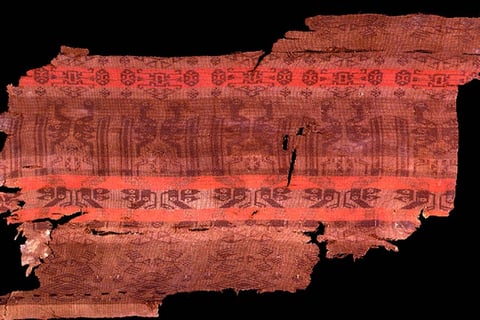Analysis of the Colors and Patterns of Silk in the Shang and Zhou Dynasties
QIPAO KNOWLEDGE
5/24/20253 min read
The Colors of Silk: Mineral Dyes and the Primary Color System
The silk dyeing technology in the Shang and Zhou Dynasties mainly relied on "mineral dyes", where natural minerals were ground to obtain pigments. The main colors included:
Red: Mainly using hematite and cinnabar. Due to its pure and stable color, cinnabar became the first choice for noble costumes. For example, the red silk fabric residues wrapping bronze wares in Shang Dynasty tombs used cinnabar.
Yellow: Realgar and orpiment (stone yellow) were used, often for noble ceremonial costumes or sacrificial items.
Cyan and Blue: Minerals such as azurite (stone green) were used, mostly for painting patterns or matching with other colors.
Black and White: Carbon black and lead white (hufen) were the basic colors. Black was often used for outlining contours, while white served as the base color or was superimposed with other colors.
In terms of color hierarchy, the Zhou Dynasty established a ritual system of "primary colors" and "secondary colors". Red, yellow, cyan, black, and white were listed as the "five primary colors" for the exclusive use of the nobility, while mixed colors (such as purple and green) were regarded as "secondary colors" for civilians or clothing linings. This system was strictly managed by officials such as "Dyer" and "Herb Dyer" in The Rites of Zhou, strengthening the social attributes of colors.
The Patterns of Silk: Geometric Patterns and Early Symbolic Symbols
The pattern design of Shang and Zhou silk was centered on geometric patterns, combining religious and power symbols:
Geometric Patterns
Thunder Patterns: The square swirling patterns commonly seen on Shang Dynasty bronze wares were also reproduced on silk. For example, the residual traces of thunder-patterned qi (a type of silk) attached to the surface of a bronze yue (axe) unearthed from the Yin Ruins in Anyang.
Fret Patterns and Diamond Patterns: Through the regular arrangement of warp and weft threads, continuous and symmetrical geometric frameworks were formed, commonly seen in jacquard fabrics, reflecting the ingenuity of early weaving techniques.
Animal Patterns
Silkworm Patterns and Dragon Patterns: Characters such as "silkworm" and "mulberry" already appeared in Shang Dynasty oracle bone inscriptions. The shape of the silkworm was abstracted and integrated into fabric patterns, symbolizing the prosperity of farming and production. In the Zhou Dynasty, dragon patterns on jade wares and bronze wares gradually appeared on silk, becoming a symbol of royal power.
Phoenix Patterns: In the Western Zhou Dynasty, the phoenix was regarded as an omen of good fortune. Its simplified lines were often combined with geometric patterns to form composite patterns of "dragon and phoenix integration".
Natural and Religious Symbols
Natural elements such as sun patterns and cloud patterns occasionally appeared in Shang and Zhou silk, mostly related to sacrificial activities. For example, in the silk fabrics unearthed from the Chu tombs of the Warring States Period, the patterns of Fusang trees (symbolizing the sun) combined with dragons and phoenixes reflected the worship of heaven and earth.
The Integration of Technology and Culture
The dyeing and pattern design of Shang and Zhou silk were not only technological achievements but also carriers of rituals and beliefs:
Technological Breakthroughs: The Shang Dynasty had mastered the multi-warp-shaft jacquard technology, capable of weaving complex geometric-patterned brocade. The Zhou Dynasty further developed "warp brocade", forming colorful effects through the alternating display of colors of different warps.
Ritual Symbols: Silk was used to wrap ritual vessels (such as jade ge and bronze wares), and their colors and patterns were directly related to the identity of the user. For example, the Zhou Dynasty rituals stipulated that the court costumes of nobles should be decorated with the "Twelve Ornaments", among which patterns such as dragons and phoenixes were only available to the emperor.
Religious Functions: As burial objects, the patterns on silk often contained the concept of immortality. For example, the silkworm patterns on the silk fabrics in Shang Dynasty tombs were not only sacrifices to the Silkworm Goddess Leizu but also embodied the life metaphor of breaking out of the cocoon and being reborn.
The colors and patterns of Shang and Zhou silk demonstrated the early Chinese civilization's ability to harness natural resources and the germination of aesthetic consciousness. The widespread use of mineral dyes established the tone of traditional Chinese colors, while the combination of geometric and symbolic patterns became the source of later silk art. These techniques not only promoted the progress of the textile industry but also, through the regulation of "rites", elevated silk to a symbol of cultural identity and social hierarchy, laying the groundwork for the prosperity of the Silk Road in the Han Dynasty
The Shang and Zhou Dynasties (approximately the 16th century BC to the 3rd century BC) were a crucial stage in the development of Chinese silk culture. During this period, silk was not only a symbol of the identity and power of the nobility but also saw the gradual formation of a system in dyeing techniques and pattern design, laying the foundation for the silk art of later generations. The following discusses the technological characteristics and cultural connotations of Shang and Zhou silk from the two aspects of colors and patterns.




